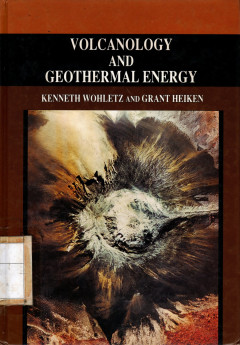Ditapis dengan

Volcanoes as Landscape Forms
This book will interest not only geologists and students of volcanoes, but all those also who have a lively interest in landforms as natural phenomena. Dr. Cotton’s emphasis is on the study of volcanoes as landscape forms, beginning with the mechanism of volcanism – the types of eruption and the various kinds of volcanoes and proceeding with a discussion of the several types of landscape wh…
- Edisi
- -
- ISBN/ISSN
- -
- Deskripsi Fisik
- 402 hal.; lamp.; gbr.;
- Judul Seri
- -
- No. Panggil
- PVG 551.21 COT V c.1

Shusaku Endo - Volcano ; Translated from the Japanese
Shortly after World War II Shusako Endo, having graduated in French Literature from Keio University in Tokyo, was the first Japanese who went to study in France, where he devoted himself to twentieth-century French Catholic literature – the works of Muriac, Bernanos Claudel, Maritain, et al. at the University of Lyons.
- Edisi
- -
- ISBN/ISSN
- 4-8053-0664-5
- Deskripsi Fisik
- 175 hal.
- Judul Seri
- -
- No. Panggil
- PVG 551.21 End v c.1

Eruptions of Hawaiian Volcanoes : Past, Present, and Future
Viewing an erupting volcano is a memorable experience, one that has inspired fear, superstition, worship, curiosity and fascination throughout the history of mankind. In modern times, volcanic phenomena have attracted intense scientific interest, because they provide the key to understanding processes that have created and shaped more than 80 percent of the Earth’s surface.
- Edisi
- -
- ISBN/ISSN
- -
- Deskripsi Fisik
- 54 hal.; gbr.; foto
- Judul Seri
- -
- No. Panggil
- PVG 551.21 TIL E c.1

Volcanology and Geothermal Energy
Los Alamos National Laboratory, with support from the U.S. Department of Energy, has been developing geothermal energy technology for nearly 20 years. The technology and experimental verification concepts developed by the Laboratory’s Hot Dry Rock Program have demonstrated tremendous potential for what is now known as heat mining- the creation of a man-made heat-exchange system in hot, fractu…
- Edisi
- -
- ISBN/ISSN
- 0-520-07914-0
- Deskripsi Fisik
- 415 hlm.; gbr.
- Judul Seri
- -
- No. Panggil
- PVG 551.21 WOH v c.1

Volcanoes - Second Edition
Volcanic activity is one of the main agents responsible for shaping the landscape, environment and climate of planets and moons. On Earth, volcanic eruption can also have catastrophic consequences for human society.
- Edisi
- -
- ISBN/ISSN
- 978-0-19-925469-9
- Deskripsi Fisik
- 519 hal.; gbr.; tabel
- Judul Seri
- -
- No. Panggil
- PVG 551.21 Fra v c.1

Volcanoes - Fourth Edition
Most of the Earths mountains, valley and plains have been slowly sculpted by uplift and erosion ever that last million years, and these, in turn, have formed from other landscape long vanished. Volcanoes though, operate on a different time scale.
- Edisi
- -
- ISBN/ISSN
- 978-0-7167-8929-1
- Deskripsi Fisik
- 326 hal.; gbr.; foto; tabel
- Judul Seri
- -
- No. Panggil
- PVG 551.21 DES V c.1

Volcanoes & Earthquakes Geologic Violence
The most fundamental part of our environment is the earth on which we live and with which we have the closest contact. This is the realm of geology, the science of the earth. The materials of the solid earth – the rocks, their structure, their alteration by geologic processes, the fossil remains of ancient life in the rock formations – these are the tools the geologist uses to reconstruct t…
- Edisi
- -
- ISBN/ISSN
- 0-07-047492-3
- Deskripsi Fisik
- 129 hal.; gbr.; tabel.
- Judul Seri
- -
- No. Panggil
- PVG 551.21 Oak v c.1

Fundamentals Of Physical Volcanology
Fundamentals of physical Volcanology is a comprehensive overview of the processes that control when and how volcanoes erupt. Understanding these processes involves bringing together ideas from a number of disciplines, including branches of geology, such as petrology and geochemistry; and aspects of physics, such as fluid dynamics and thermodynamics.
- Edisi
- -
- ISBN/ISSN
- 978-0-632-05443-5
- Deskripsi Fisik
- 219 hal.; gbr.; tabel
- Judul Seri
- -
- No. Panggil
- PVG 551.21 PAR F c.3

My Experiments With Volcanoes
This , My Latest Book, is another experiment. After sixty years of volcanoes I have learned reversal of preconceived notions. Gradually I have learned a totally different approach. Shaler of Harvard was my inspirer, worker in the wonder of swamp and ice and sea beaches.
- Edisi
- -
- ISBN/ISSN
- -
- Deskripsi Fisik
- 198 hal.; foto
- Judul Seri
- -
- No. Panggil
- PVG 551.21 JAG M c.1
 Karya Umum
Karya Umum  Filsafat
Filsafat  Agama
Agama  Ilmu-ilmu Sosial
Ilmu-ilmu Sosial  Bahasa
Bahasa  Ilmu-ilmu Murni
Ilmu-ilmu Murni  Ilmu-ilmu Terapan
Ilmu-ilmu Terapan  Kesenian, Hiburan, dan Olahraga
Kesenian, Hiburan, dan Olahraga  Kesusastraan
Kesusastraan  Geografi dan Sejarah
Geografi dan Sejarah